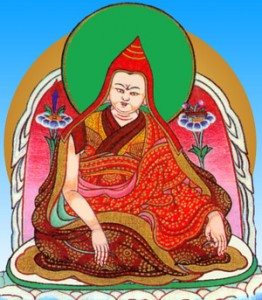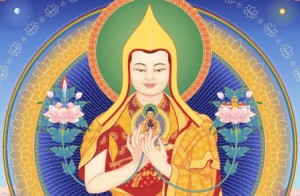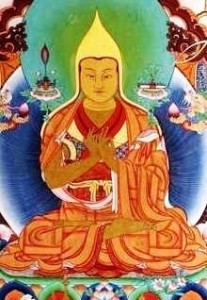
The following is respectfully taken from “Drops of Nectar” by Ngagyur Nyingma Institute:
Biography of Longchen Rabjam (1308-1363)
Having acquired the enlightened intention of Dharmakaya in the expanse of exhausted phenomena,
And having seen the pure realm of Sambhogakaya in the sphere of luminosity,
He appears in Nirmanakaya form to untamed beings and benefits them through his enlightened activities.
To Longchenpa, the omniscient King of Dharma, I pay homage.
As stated in the Compendium of Sutras:
“One who possesses the wisdom that realizes the unborn nature
and the supreme quiescence of contemplation
Is a Bodhisattva who is adept in calm abiding
Thus it was prophesied by the Buddhas of the past.”
In the chronicles of Guru Padmasambhava entitled, “Sheldragma” it says;
“In the Monkey Year, my emanation will be born who is endowed with wisdom and sharp intellect. He will bless the Land of Jewels, Bumthang, guide fortunate ones and reveal treasure teachings from the lower part of the region. At that time I will be known as Drimed Ozer.”
As clearly prophesied in authentic scriptures, one of the Three Great Emanations of Manjushri in the Land of Snows, the Omniscient Kind of Dharma, Longchen Rabjam was born in Todrong village situated in the Tra valley of Yoru, middle part of U Tang province, on Saturday, 2nd March 1308 (10th day, 2nd Month, Earth Monkey Year of the Fifth Rabjung Cycle.)
His grandfather Lhasung, who lived for one hundred and five years, was a descendent of Gyalwa Choyang, one of the Seven Intelligents who were tested. His father, Lopon Tenpa Sung, was a master of the sciences and tantric practices, and his mother Dromza Sonam Gyen, was a descendent of the family of Dromton Gyalwai Jungne, the foremost disciple of Atisha.
Immediately after his birth, the Dharma protectress Namdru Remati appeared. Holding the baby in her arms, she said, “I shall protect him!” After returning the newborn back to the mother, she disappeared. From then onwards, the deity served him in various physical forms. From childhood, he naturally possessed the noble qualities of a bodhisattva such as faith, compassion and wisdom. At the age of five, he learned how to read and write. He received many esoteric teachings like, “The Eight Transmitted Precepts on the Gathering of the Sugatas” as well as other sciences.
When he was only 12, he understood the nature of samsara and felt that, like a nest of poisonous snakes, a pit of fire, and a continent of demons, he saw the world was not a safe place to live. He realized the only means of freedom from the suffering of samsara was to practice pure moral ethics, the basis of all noble qualities. Therefore, he gave up all worldly affairs and the clothing of a layperson and went to Samye, the monastery where he received the novice vows from Khenpo Samdrup Rinchen, Lopon Kunga Ozer and accurate number of sangha, who possessed both qualities of scholar and strict observer of moral discipline. After ordination, he was given the name Tshultrim Lodroe. He studied the vinaya teachings and without much difficulty, he understood it perfectly, which enabled him to teach it to others.
At nineteen, he went to the great university of Sangphu Neuthok, a popular center for advanced studies that was founded by Ngog Lekpei Sherab, the reputed Tibetan scholar of logic. There, under Lopon Tsengonpa and Ladrangpa Chopel Gyaltsen, he studied the Buddhist teachings of the Causal Vehicle including Maitreya’s Five Classes of Teachings, Dharmakirti’s Seven Treatises on Valid Cognition, the Madhyamika philosophy,Pranjnaparamita and so on. He also received the five profound sutras, which include the Samadhirajsutra (Sutra of the King of Contemplation) from Pang Lodroe Tenpa. In addition, he learned the common sciences of poetry, grammar, prosody, so forth, and mastered whatever he studied. He propitiated various deities such as Manjushri, Achala and as a sign of accomplishment; he had visions of these deities. Particularly Saraswati, the Goddess of Melody, placed him in the palm of her hand and showed him the four continents and Mt. Meru in seven days. At that time, Saraswati prophesied that he would become a great master and benefit countless beings in the future. After having this particular vision, he actualized the spiritual attainment of unobstructed intelligence, due to which he displayed fearless confidence in the ocean of scriptural teachings and reasoning. Thus, he came to be popularly known as Samye Lung Mangwa (Master from Samye who holds the Treasury of Scriptural Knowledge), and the great drum of his fame resounded in all directions.
He received the Trio of the Sutra with Gathers All Intentions, Magical Net Tantra and the Mental Classes as well as the collected tantras of the Nyingmapa tradition from Lopon Zhonu Dhondrup. Karma Rangjung Dorje bestowed him the empowerment and explanation on the Six Applications, the Means to Dispel Obstacles, the Six Yoga Trainings of Naropa and the introduction to the three truth bodies. From the supreme master of the Sakya tradition, Dampa Sonam Gyaltsen, he received the entire instructions on the Lamdre Chenmo (Great path and fruit), the three visions and three tantras. Lopon Zhongyel transmitted him the Chandrakirti’s Prasanapada (Clear worded Commentary) and the Madyamakavatara (Introduction to the Middle Way). Following more than twenty spiritual masters from all the different schools of Buddhism, he mastered all the renowned tenet systems existing in Tibet.
Immensely disgusted and fed up with samsara, he resolved to live in solitude. The constant provocation by his fellow monks also added fuel to the fire thus compelling him to leave all worldly cares. On his way he had the auspicious and miraculous signs of meeting the teachings of Dzogpachenpo.
At the age of 29, he met Vidyadhara Rigdzin Kumaraza (1266-1343) in the upper part of Yartokyam valley, who took care of him with great compassion. The master always moved from place to place in order to free all his disciples from attachment to the material world never settling anywhere for long.
During the spring and summer of that year, Longchenpa wandered nine times from one deserted valley to the next due to which he faced many hardships surviving on three measures of flour and twenty-one mercury pills for two months. In the bitter cold of snowy winter, he lived on a sack garment, which served him as both a robe and a bed. He endured such inconceivable austerity for the sake of dharma, following the example of Milarepa.
After serving his root master with the three kinds of delight, his master conferred him all the transmissions and esoteric instructions on the three classes of Dzogchen together with the rites of the protectress. Hereby he was appointed as the lineage holder of the teachings.
At 32, when he gave the Nyingthig (Innermost Spirituality) teachings to eighteen fortunate yogis and yoginis, Ekasati, the protectress of Nyingthig appeared and served him at his command. At that time, Khandro Yeshe Tsogyal got into one of the yoginis and showed him the symbols, meanings and texts of the Khandro Nyingthig (Teachings of Innermost Spirituality transmitted from Guru Rinpoche) together with the entrustment seal. Thus, he is the direct recipient of the Khandro Nyingthig teachings.
As prophesied by Vimalamitra, during the renovation of the monastery of Zha in Uru, he arose in the wrathful form of Padmasambhava and pacified all the negative forces. During the consecration ceremony, he had the clear vision of Buddha Shakyamuni, Maitreya and the Sixteen Arhats. Particularly, Maitreya prophesied thus, “Your final birth will be in the pure realm of Pema Tsekpa where you will be enlightened as the Buddha Rirab Marmei Gyaltsen.”
Knowing the forthcoming conflict between the Sakya and Phagmodrubpa, Longchen Rabjam went to Bumthang. There he founded a monastery called Tharpa Ling (Palace of Liberation) with a gathering of monks. His enlightened activities enhanced the widespread propagation of Nyingma teachings in general and the Dzogchen teachings in particular.
When he returned to Lhasa and visited the image of Buddha Shakyamuni, (Jowo) light rays were emitted from the circle of hair between the eyebrows and dissolved between his eyebrows, which enabled him to recollect his former lives as a scholar at Vulture Peak and in Khotan. While expounding the vast teachings such as Bodhicitta at Lhasa and Ramoche, he subdued the pride of many learned Geshes who were there to test the level of his spiritual understanding and intellect, through his scriptural quotes and logical reasoning. In this way, he established them in ascertained faith and as a result, he was later addressed as “Kunkhyen Choeje” (All Knowing King of Dharma). Thus, his name and fame spread widely in all directions.
He had innumerable visions of the buddhas and bodhisattvas and with their encouragement and approval, he composed many treatises including Seven Great Precious Treasuries, the “Triology of Rest” and so forth, as mind treasure teachings. His works also include common study like prosody, up to the most profound Dzogchen teachings like Nyingthik Yabshi (The Four Parts of the Innermost Spirituality). Thus, his compositions totals to more than two hundred and fifty categories of teachings. All his teachings have these seven distinct qualities:
- With his knowledge of orthography, his writings delight the learned ones.
- Their profound meanings have the ability to liberate the fortunate ones.
- They are the image of ultimate realization that will exhilarate followers.
- They are like a spiritual friend who shows what to follow and what to discard.
- They are the roar of the lion that surpasses all opponents.
- They are the rays of the sun and moon, which illuminate the teachings of the Conquerors.
- They are the pinnacle of teachings adorned with precious gems.
In short, his teachings were no different from the direct teachings of Buddha Samantabhadra. They have the unique characteristics of elucidating the correct meanings with the clear words; uncomplicated and perfectly pure that cleanses all the negativities and obscurations. With compassion, he composed works for the well being of future disciples. In particular, while composing the Seven Treasuries at Gangri Thodkar, his attendant witnessed how Longchenpa ordered Vishnu to prepare ink for writing.
Longchenpa meditated in total isolation at various places like Gangri Thodkar, Samye, Chimpu and so forth. He spent most of his later life at Gangri Thodkar. Because of his boundless compassion towards his increasing gathering of disciples, he never accepted payment for his teachings and never wasted offerings made by the faithful. Concentrating only on the welfare of others, he tolerated all misdeeds of his disciples. His enlightened activities of skillful means were unbelievable, like knowing other’s minds and so forth.
Seeing his miraculous activities and scholastic achievements, even powerful persons in Tibet like Gompa Kunrin of Drigung, Situ Jangchub Gyaltsen, Yadrog Tripon and many others honored him like their precious crown yet had neither pride nor expectations of reward. He particularly loved the poor, sick and humble and he would joyfully accept their invitation as well as their frugal offerings without any arrogance. No matter how poor the food served to him was, he would eat it as if it were a great treat. He would then recite the sutras and the dedicational prayers with enthusiasm.
Ever ready to sacrifice his life and body for the welfare of others he was trained in the ocean-like conduct of the bodhisattvas. After accomplishing limitless benevolent deeds for his disciples, he intended to demonstrate his final enlightened activity. So at the age of 56, in the year 1363 (Water Hare Year, Six Rabjung Cycle), he went to the charnel ground in the Chimpu forest and said to Gyalse Zoepa, “Having understood the nature of samsara from the beginning, as there is no essence in the worldly things, I will discard this illusory body of impermanence, so, listen to this esoteric instruction which is of sole benefit.”
On the eighteenth of that month, leaving behind his last will, he relaxed in the sphere of the primordial nature, in the posture of Dharmakaya. The earth trembled at the time and countless miracles occurred. When his mind entered the state of the Dharmakaya, even the four seasons lost their fixed order. After his cremation, to indicate his attainment of enlightened body, speech and mind, his heart, tongue and eyes remained intact and fell into the laps of fortunate disciples.
Longchen Rabjam’s main disciples, who experienced the nectar of his enlightened speech, were the three learned and accomplished ones Deleg Gyamtso and others, the five sons of his enlightened mind were Gyalse Zoepa and so forth, his four spiritual friends included Tulku Paljor Gyamtso.




